Polyethylene Glycol-Chitosan Oligosaccharide-Coated Superparamagnetic Iron Oxide Nanoparticles: A Novel Drug Delivery System for Curcumin Diglutaric Acid
Abstract
1. Introduction
2. Materials and Methods
2.1. Chemicals and Reagents
2.2. Cell Culture
2.3. Fabrication of Core-Shell NPs
2.3.1. Fabrication of SPIONs
2.3.2. Coating SPIONs with CSO and PEG
2.3.3. Loading of CG onto the PEG-CSO-SPIONs
2.4. Experimental Design
2.4.1. Factorial Design for Preparation of CG-PEG-CSO-SPIONs
2.4.2. Graphical Drawing, Optimization, and Statistical Analysis
2.5. Characterization of the NPs
2.6. In Vitro Release of CG: Kinetics
2.7. In Vitro Protein Binding
2.8. Storage Stability of CG-PEG-CSO-SPIONs
2.9. Cell Experiments
2.9.1. Cytotoxicity Studies
2.9.2. In Vitro Cellular Uptake
2.9.3. Magnetic Targeting Delivery Assay
2.10. Statistical Analysis
3. Results and Discussion
3.1. Optimization of the CG-PEG-CSO-SPIONs by PBD and BBD
3.2. Characterization of the NPs
3.3. In Vitro CG Release Kinetics from the Optimized CG-PEG-CSO-SPIONs
3.4. In Vitro Protein Binding
3.5. Storage Stability
3.6. Cytotoxicity Studies
3.7. In Vitro Cellular Uptake of CG
3.8. Magnetic Targeted Delivery
4. Conclusions
Author Contributions
Funding
Acknowledgments
Conflicts of Interest
References
- Gupta, A.K.; Wells, S. Surface-modified superparamagnetic nanoparticles for drug delivery: Preparation, characterization, and cytotoxicity studies. IEEE Trans. Nanobiosci. 2004, 3, 66–73. [Google Scholar] [CrossRef] [PubMed]
- Kumar, P.; Agnihotri, S.; Roy, I. Preparation and characterization of superparamagnetic iron oxide nanoparticles for magnetically guided drug delivery. Int. J. Nanomed. 2018, 13, 43–46. [Google Scholar] [CrossRef] [PubMed]
- Miranda, M.S.; Rodrigues, M.T.; Domingues, R.M.A.; Costa, R.R.; Paz, E.; Rodríguez-Abreu, C.; Freitas, P.; Almeida, B.G.; Carvalho, M.A.; Gonçalves, C.; et al. Development of inhalable superparamagnetic iron oxide nanoparticles (SPIONs) in microparticulate system for antituberculosis drug delivery. Adv. Healthc. Mater. 2018, 7, 1800124. [Google Scholar]
- Satari, M.; Haghighat, N.; Jouni, F.J.; Abodolmaleki, P. Effects of synthesized superparamagnetic iron oxide nanoparticles and extremely low frequency. Multidiscip. Cancer Investig. 2018, 2, 13–21. [Google Scholar] [CrossRef][Green Version]
- Kheirkhah, P.; Denyer, S.; Bhimani, A.D.; Arnone, G.D.; Esfahani, D.R.; Aguilar, T.; Zakrzewski, J.; Venugopal, I.; Habib, N.; Gallia, G.L.; et al. Magnetic drug targeting: A novel treatment for intramedullary spinal cord tumors. Sci. Rep. 2018, 8, 11417. [Google Scholar] [CrossRef]
- Silva, V.A.J.; Andrade, P.L.; Silva, M.P.C.; Bustamante Dominguez, A.; De Los Santos Valladares, L.; Albino Aguiar, J. Synthesis and characterization of Fe3O4 nanoparticles coated with fucan polysaccharides. J. Magn. Magn. Mater. 2013, 343, 138–143. [Google Scholar] [CrossRef]
- Muthiah, M.; Park, I.K.; Cho, C.S. Surface modification of iron oxide nanoparticles by biocompatible polymers for tissue imaging and targeting. Biotechnol. Adv. 2013, 31, 1224–1236. [Google Scholar] [CrossRef]
- Zhu, N.; Ji, H.; Yu, P.; Niu, J.; Farooq, M.U.; Waseem Akram, M.; Udego, I.O.; Li, H.; Niu, X. Surface modification of magnetic iron oxide nanoparticles. Nanomaterials 2018, 8, 810. [Google Scholar] [CrossRef]
- Lertsutthiwong, P.; Rojsitthisak, P. Chitosan-alginate nanocapsules for encapsulation of turmeric oil. Pharmazie 2011, 66, 911–915. [Google Scholar]
- Iconaru, S.L.; Prodan, A.M.; Motelica-Heino, M.; Sizaret, S.; Predoi, D. Synthesis and characterization of polysaccharide-maghemite composite nanoparticles and their antibacterial properties. Nanoscale Res. Lett. 2012, 7, 576. [Google Scholar] [CrossRef]
- Bhunchu, S.; Rojsitthisak, P. Biopolymeric alginate-chitosan nanoparticles as drug delivery carriers for cancer therapy. Pharmazie 2014, 69, 563–570. [Google Scholar] [PubMed]
- Uthaman, S.; Lee, S.J.; Cherukula, K.; Cho, C.S.; Park, I.K. Polysaccharide-coated magnetic nanoparticles for imaging and gene therapy. Biomed. Res. Int. 2015, 959175. [Google Scholar] [CrossRef] [PubMed]
- Sorasitthiyanukarn, F.N.; Ratnatilaka Na Bhuket, P.; Muangnoi, C.; Rojsitthisak, P.; Rojsitthisak, P. Chitosan/alginate nanoparticles as a promising carrier of novel curcumin diethyl diglutarate. Int. J. Biol. Macromol. 2019, 131, 1125–1136. [Google Scholar] [CrossRef] [PubMed]
- Mourya, V.K.; Inamdar, N.N. Chitosan-modifications and applications: Opportunities galore. React. Funct. Polym. 2008, 68, 1013–1051. [Google Scholar] [CrossRef]
- Mohammedi, Z. Chitosan and chitosan oligosaccharides: Applications in medicine, agriculture and biotechnology. IJBC 2017, 2, 102–106. [Google Scholar]
- Bae, K.H.; Park, M.; Do, M.J.; Lee, N.; Ryu, J.H.; Kim, G.W.; Kim, C.G.; Park, T.G.; Hyeon, T. Chitosan oligosaccharide-stabilized ferrimagnetic iron oxide nanocubes for magnetically modulated cancer hyperthermia. ACS Nano 2012, 6, 5266–5273. [Google Scholar] [CrossRef]
- Shukla, S.; Jadaun, A.; Arora, V.; Sinha, R.K.; Biyani, N.; Jain, V.K. In vitro toxicity assessment of chitosan oligosaccharide coated iron oxide nanoparticles. Toxicol. Rep. 2015, 2, 27–39. [Google Scholar] [CrossRef]
- Bailon, P.; Won, C.Y. PEG-modified biopharmaceuticals. Expert Opin. Drug Deliv. 2009, 6, 1–16. [Google Scholar] [CrossRef]
- Knop, K.; Hoogenboom, R.; Fischer, D.; Schubert, U.S. Poly (ethylene glycol) in drug delivery: Pros and cons as well as potential alternatives. Angew. Chem. Int. Ed. 2010, 49, 6288–6308. [Google Scholar] [CrossRef]
- D’souza, A.A.; Shegokar, R. Polyethylene glycol (PEG): A versatile polymer for pharmaceutical applications. Expert Opin. Drug Deliv. 2016, 13, 1257–1275. [Google Scholar] [CrossRef]
- Qu, J.B.; Shao, H.H.; Jing, G.L.; Huang, F. PEG-chitosan-coated iron oxide nanoparticles with high saturated magnetization as carriers of 10-hydroxycamptothecin: Preparation, characterization and cytotoxicity studies. Colloids Surf. B Biointerfaces 2013, 102, 37–44. [Google Scholar] [CrossRef] [PubMed]
- Su, Y.; Hu, Y.; Du, Y.; Huang, X.; He, J.; You, J.; Yuan, H.; Hu, F. Redox-responsive polymer-drug conjugates based on doxorubicin and chitosan oligosaccharide-g-stearic acid for cancer therapy. Mol. Pharm. 2015, 12, 1193–1202. [Google Scholar] [CrossRef] [PubMed]
- Muangnoi, C.; Jithavech, P.; Ratnatilaka Na Bhuket, P.; Supasena, W.; Wichitnithad, W.; Towiwat, P.; Niwattisaiwong, N.; Haworth, I.S.; Rojsitthisak, P. A curcumin-diglutaric acid conjugated prodrug with improved water solubility and antinociceptive properties compared to curcumin. Biosci. Biotechnol. Biochem. 2018, 82, 1301–1308. [Google Scholar] [CrossRef] [PubMed]
- Prabha, G.; Raj, V. Preparation and characterization of chitosan-polyethylene glycol-polyvinylpyrrolidone-coated superparamagnetic iron oxide nanoparticles as carrier system: Drug loading and in vitro drug release study. J. Biomed. Mater. Res. B Appl. Biomater. 2016, 104, 808–816. [Google Scholar] [CrossRef] [PubMed]
- Pham, X.N.; Nguyen, T.P.; Pham, T.N.; Tran, T.T.N.; Tran, T.V.T. Synthesis and characterization of chitosan-coated magnetite nanoparticles and their application in curcumin drug delivery. Adv. Nat. Sci. Nanosci. Nanotechnol. 2016, 7, 045010. [Google Scholar] [CrossRef]
- Yuksel, N.; Kanik, A.E.; Baykara, T. Comparison of in vitro dissolution profiles by ANOVA-based, model-dependent and -independent methods. Int. J. Pharm. 2000, 209, 57–67. [Google Scholar] [CrossRef]
- Zhang, Y.; Huo, M.; Zhou, J.; Zou, A.; Li, W.; Yao, C.; Xie, S. DDSolver: An add-in program for modeling and comparison of drug dissolution profiles. AAPS J. 2010, 12, 263–271. [Google Scholar] [CrossRef]
- Siepmann, J.; Siepmann, F. Mathematical modeling of drug delivery. Int. J. Pharm. 2008, 364, 328–343. [Google Scholar] [CrossRef]
- Yallapu, M.M.; Othman, S.F.; Curtis, E.T.; Bauer, N.A.; Chauhan, N.; Kumar, D.; Jaggi, M.; Chauhan, S.C. Curcumin-loaded magnetic nanoparticles for breast cancer therapeutics and imaging applications. Int. J. Nanomed. 2012, 7, 1761–1779. [Google Scholar]
- Kouchakzadeh, H.; Hoseini Makarem, S.; Shojaosadati, S.A. Simultaneous loading of 5-florouracil and SPIONs in HSA nanoparticles: Optimization of preparation, characterization and in vitro drug release study. Nanomed. J. 2016, 3, 35–42. [Google Scholar]
- ICHHT Guideline. Stability Testing of New Drug Substances and Products; The International Council for Harmonisation (ICH): Geneva, Switzerland, 2003; pp. 1–24. [Google Scholar]
- Sorasitthiyanukarn, F.N.; Ratnatilaka Na Bhuket, P.; Muangnoi, C.; Rojsitthisak, P.; Rojsitthisak, P. Chitosan/alginate nanoparticles as a promising approach for oral delivery of curcumin diglutaric acid for cancer treatment. Mater. Sci. Eng. C 2018, 93, 178–190. [Google Scholar] [CrossRef] [PubMed]
- Mohammadi-Samani, S.; Miri, R.; Salmanpour, M.; Khalighian, N.; Sotoudeh, S.; Erfani, N. Preparation and assessment of chitosan-coated superparamagnetic Fe3O4 nanoparticles for controlled delivery of methotrexate. Res. Pharm. Sci. 2013, 8, 25–33. [Google Scholar] [PubMed]
- Shete, P.B.; Patil, R.M.; Thorat, N.D.; Prasad, A.; Ningthoujam, R.S.; Ghosh, S.J.; Pawar, S.H. Magnetic chitosan nanocomposite for hyperthermia therapy application: Preparation, characterization and in vitro experiments. Appl. Surf. Sci. 2014, 288, 149–157. [Google Scholar] [CrossRef]
- Mahdavi, M.; Ahmad, M.B.; Haron, M.J.; Namvar, F.; Nadi, B.; Ab Rahman, M.Z.; Amin, J. Synthesis, surface modification and characterization of biocompatible magnetic iron oxide nanoparticles for biomedical applications. Molecules 2013, 18, 7533–7548. [Google Scholar] [CrossRef] [PubMed]
- Amiji, M.M. Synthesis of anionic poly (ethylene glycol) derivative for chitosan surface modification in blood-contacting applications. Carbohydr. Polym. 1997, 32, 193–199. [Google Scholar] [CrossRef]
- Nam, K.S.; Kim, M.K.; Shon, Y.H. Chemopreventive effect of chitosan oligosaccharide against colon carcinogenesis. J. Microbiol. Biotechnol. 2007, 17, 1546–1549. [Google Scholar]
- Zaman, M.S.; Chauhan, N.; Yallapu, M.M.; Gara, R.K.; Maher, D.M.; Kumari, S.; Sikander, M.; Khan, S.; Zafar, N.; Jaggi, M.; et al. Curcumin nanoformulation for cervical cancer treatment. Sci. Rep. 2016, 6, 20051. [Google Scholar] [CrossRef]
- Jagannathan, R.; Abraham, P.M.; Poddar, P. Temperature-dependent spectroscopic evidences of curcumin in aqueous medium: A mechanistic study of its solubility and stability. J. Phys. Chem. B 2012, 116, 14533–14540. [Google Scholar] [CrossRef]

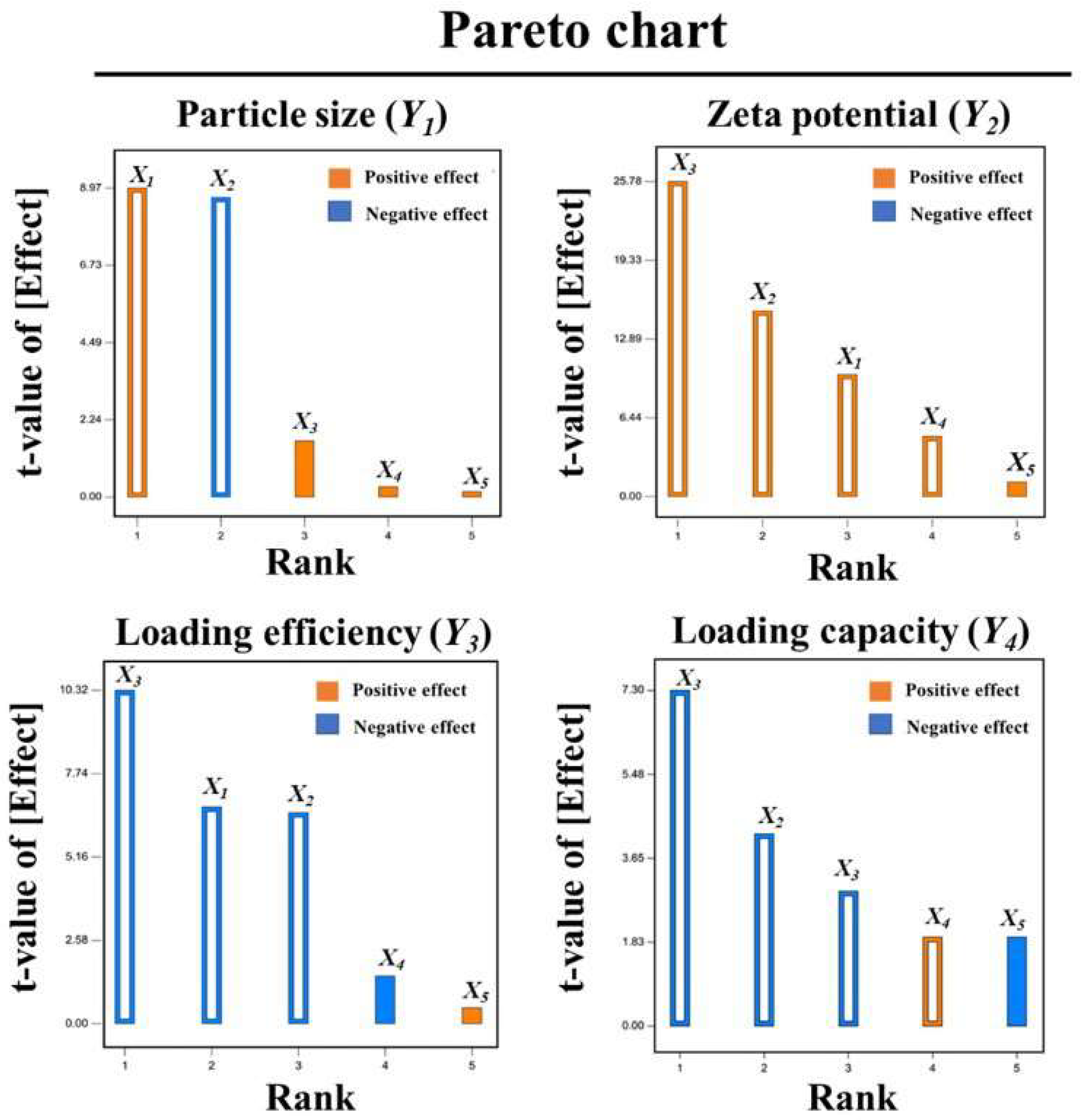
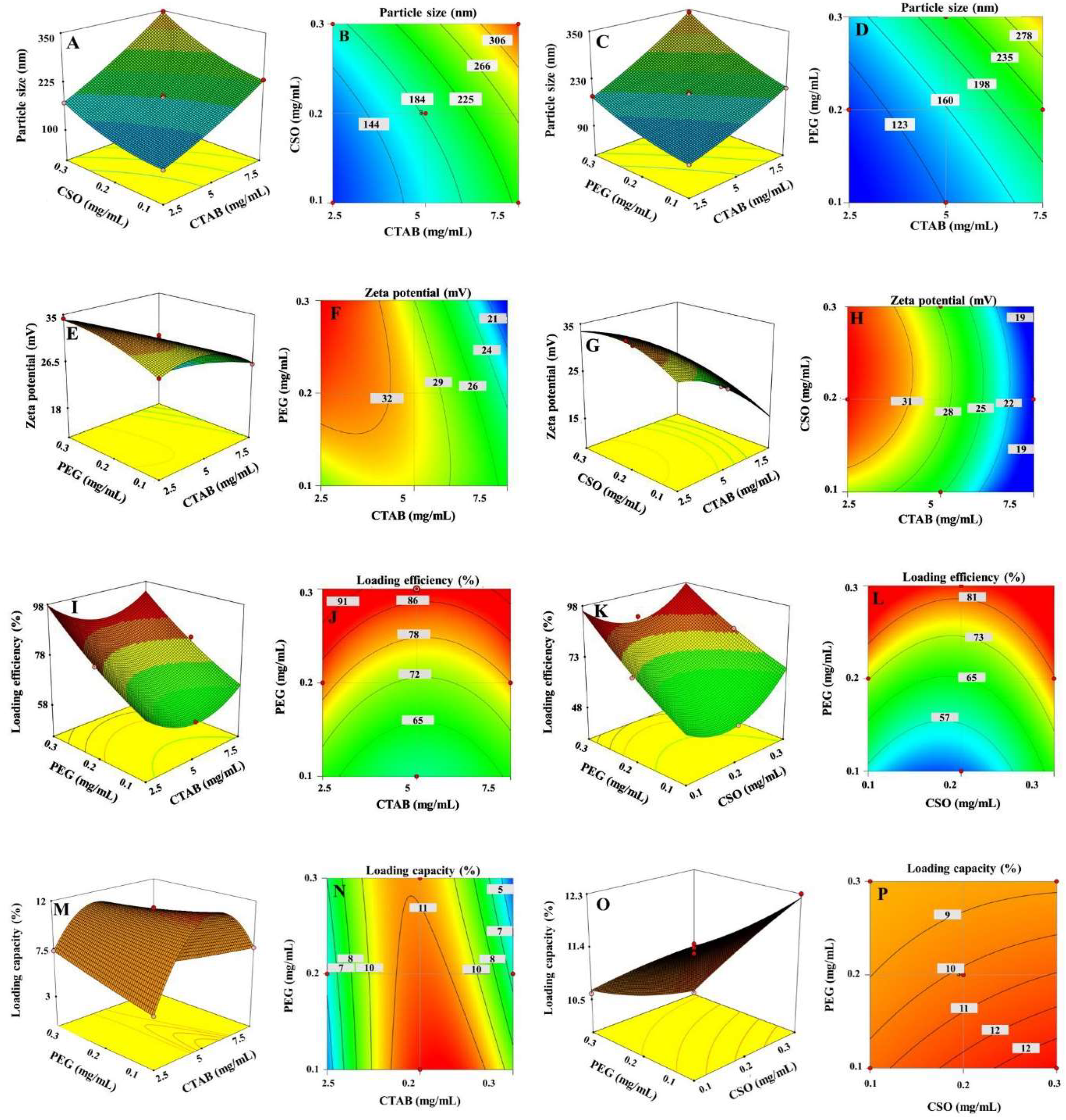
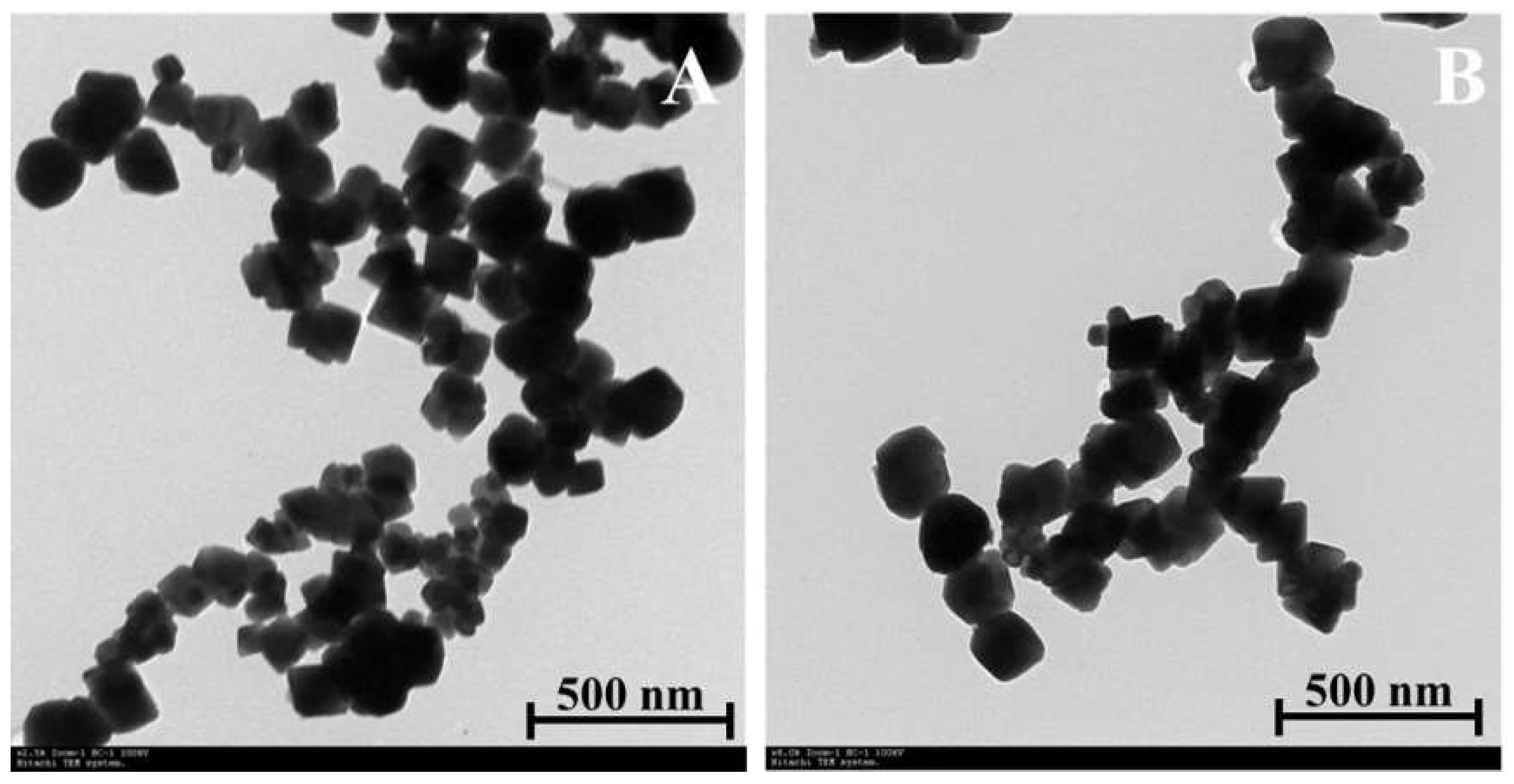
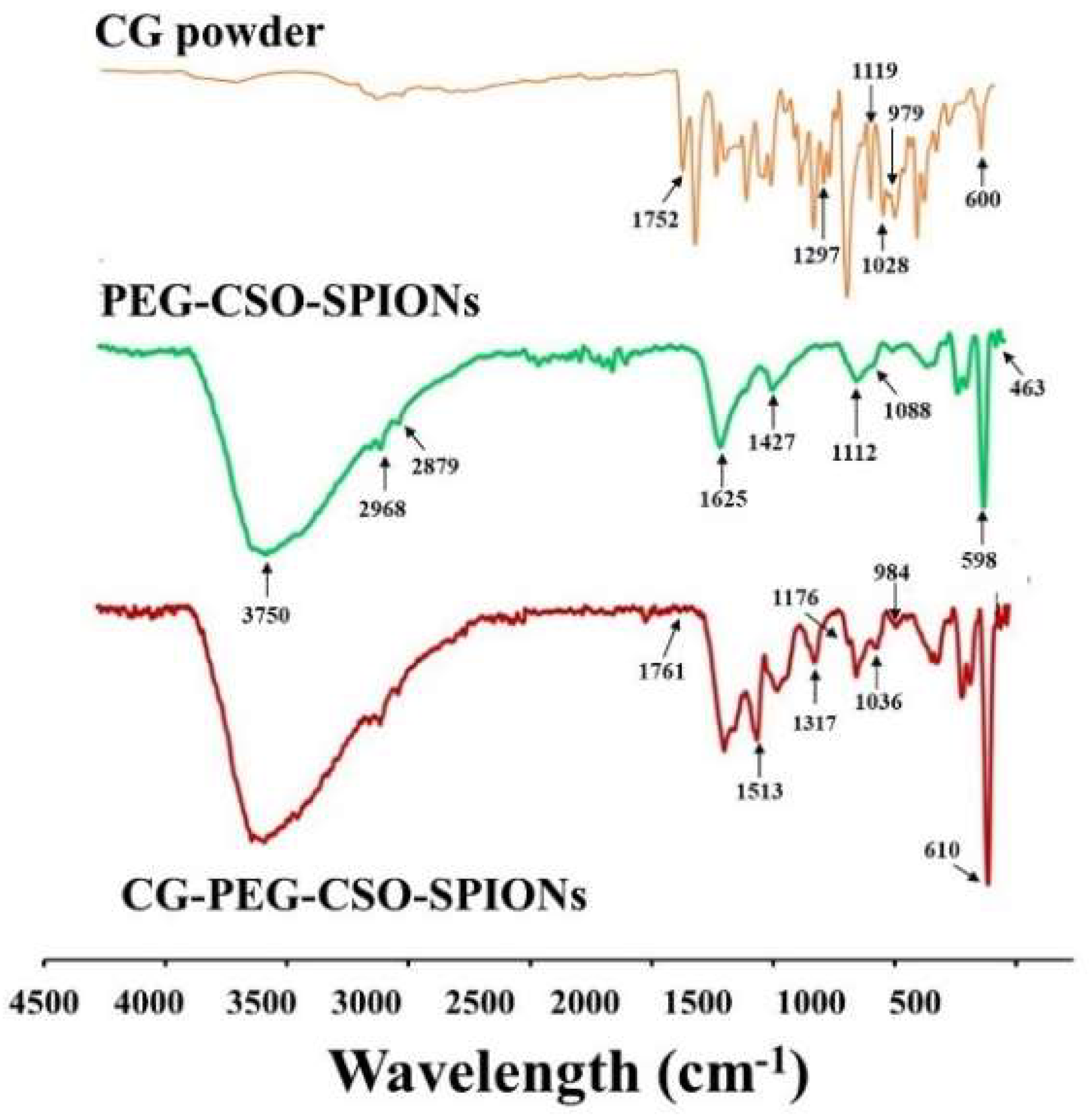
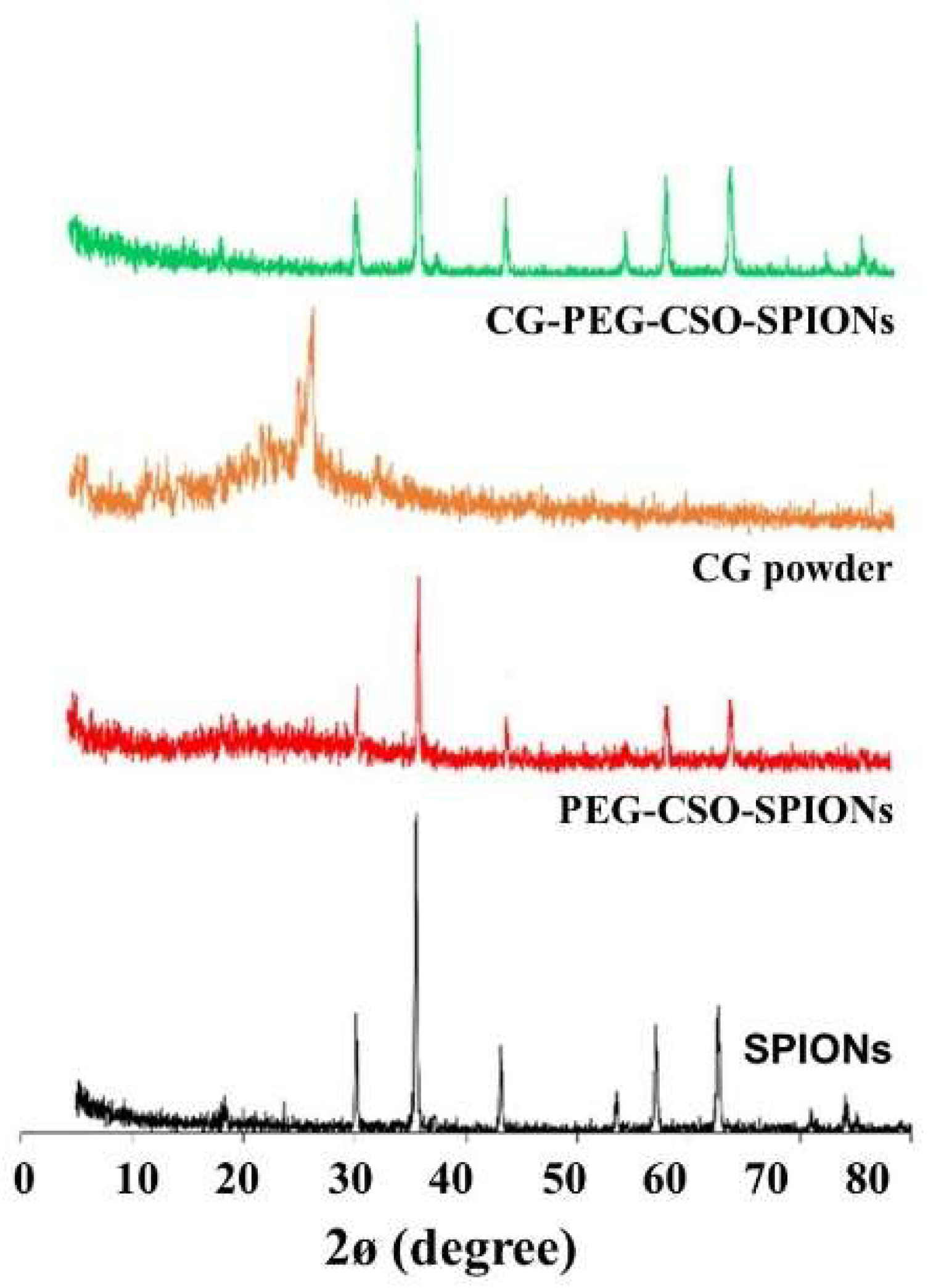
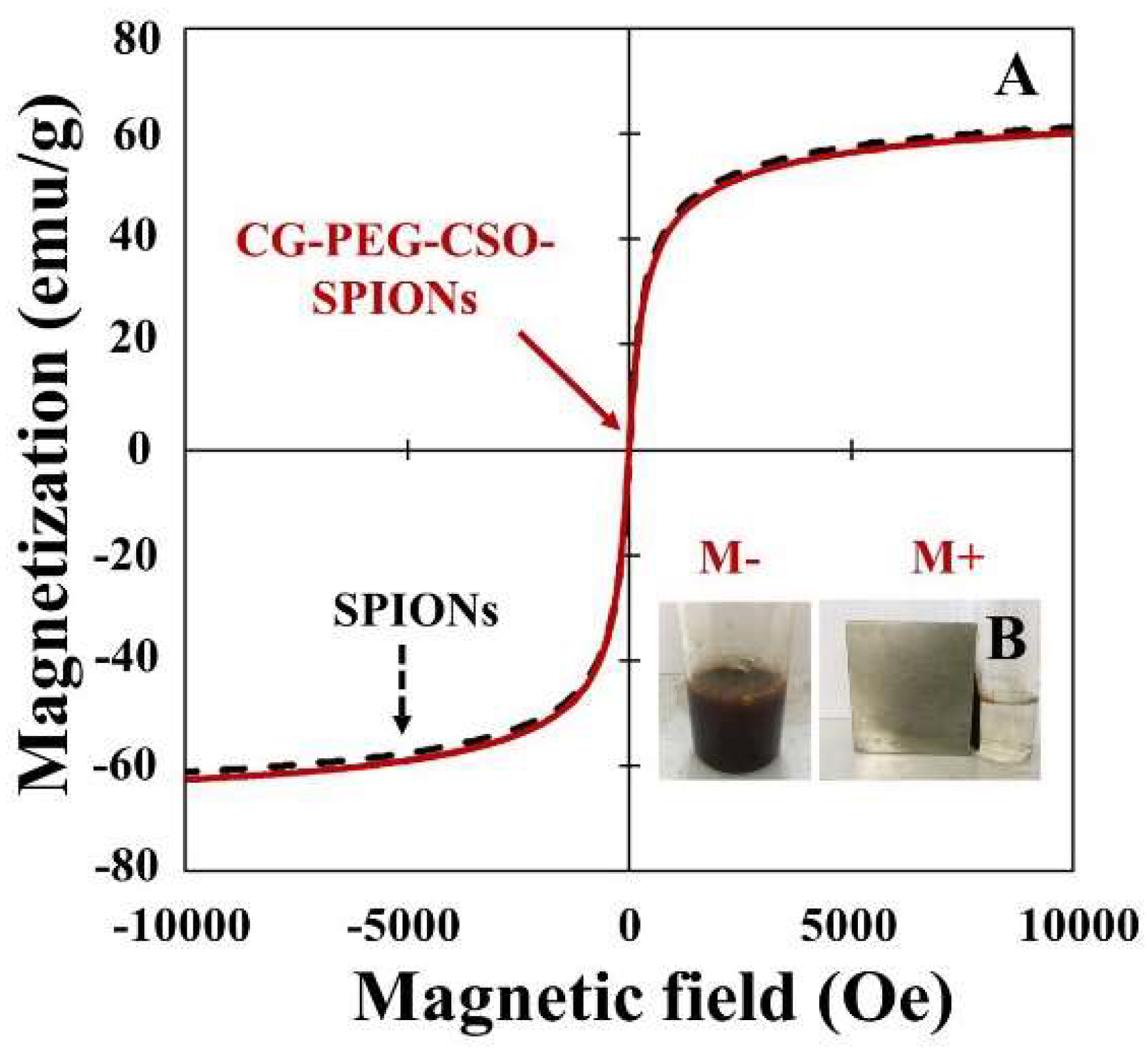
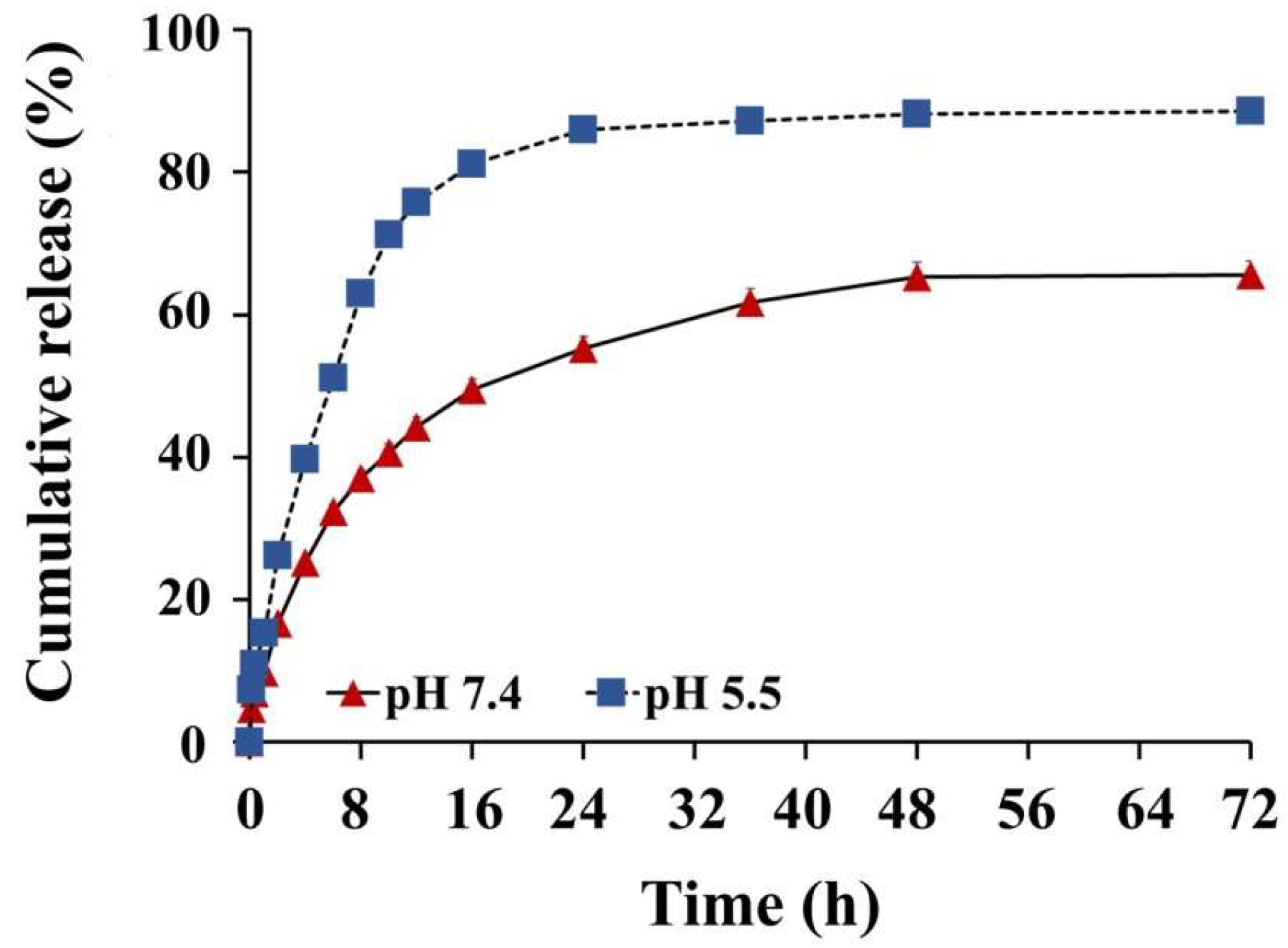
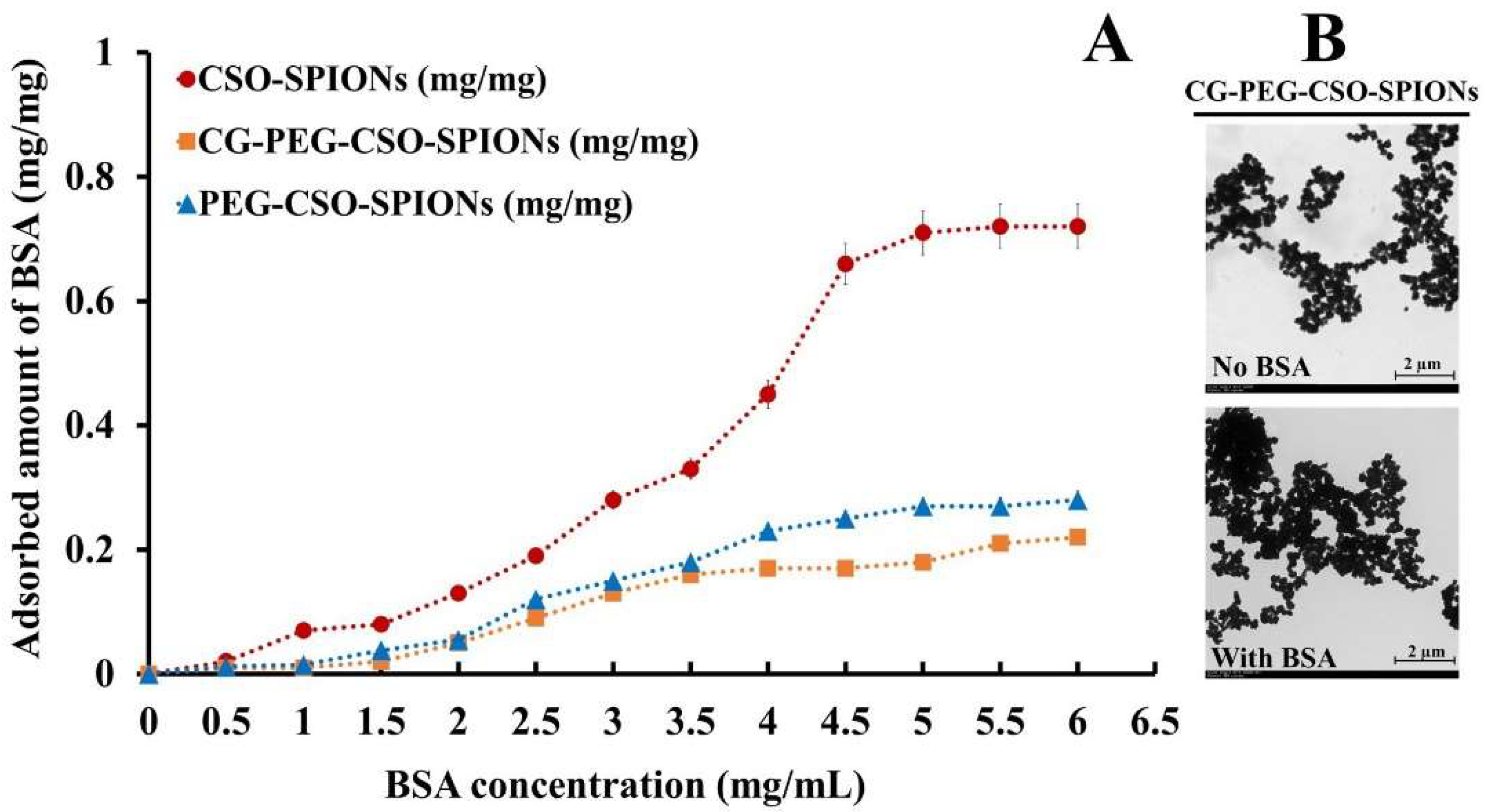
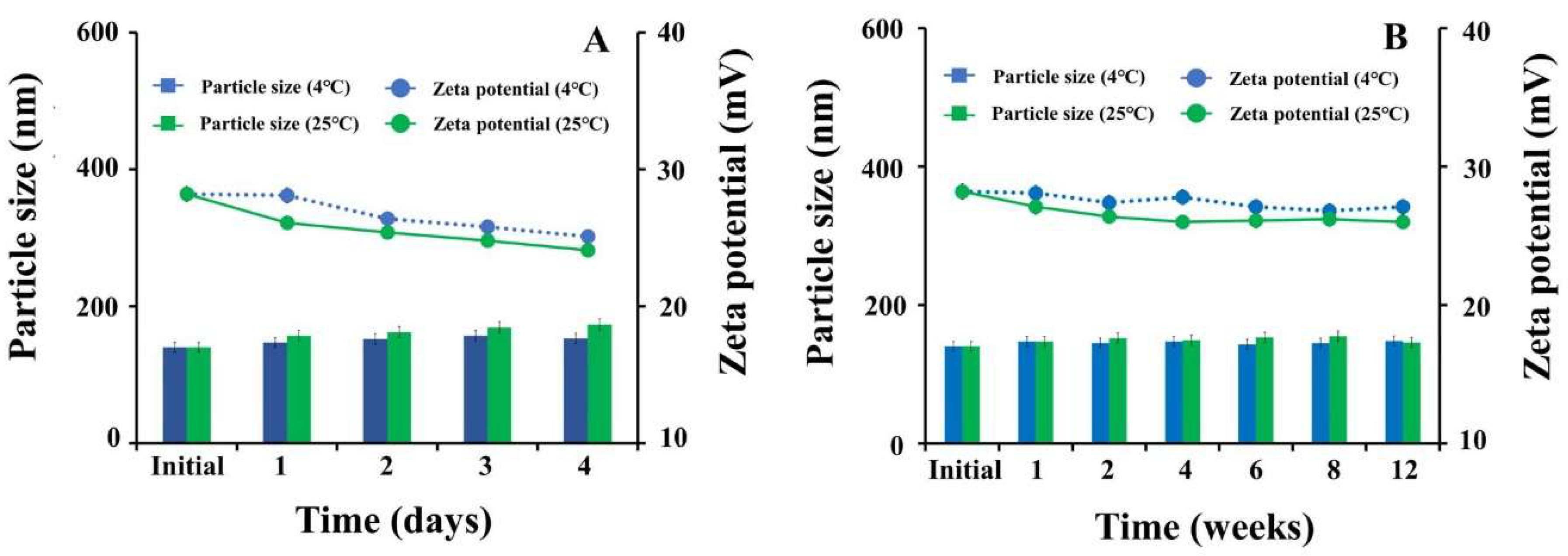
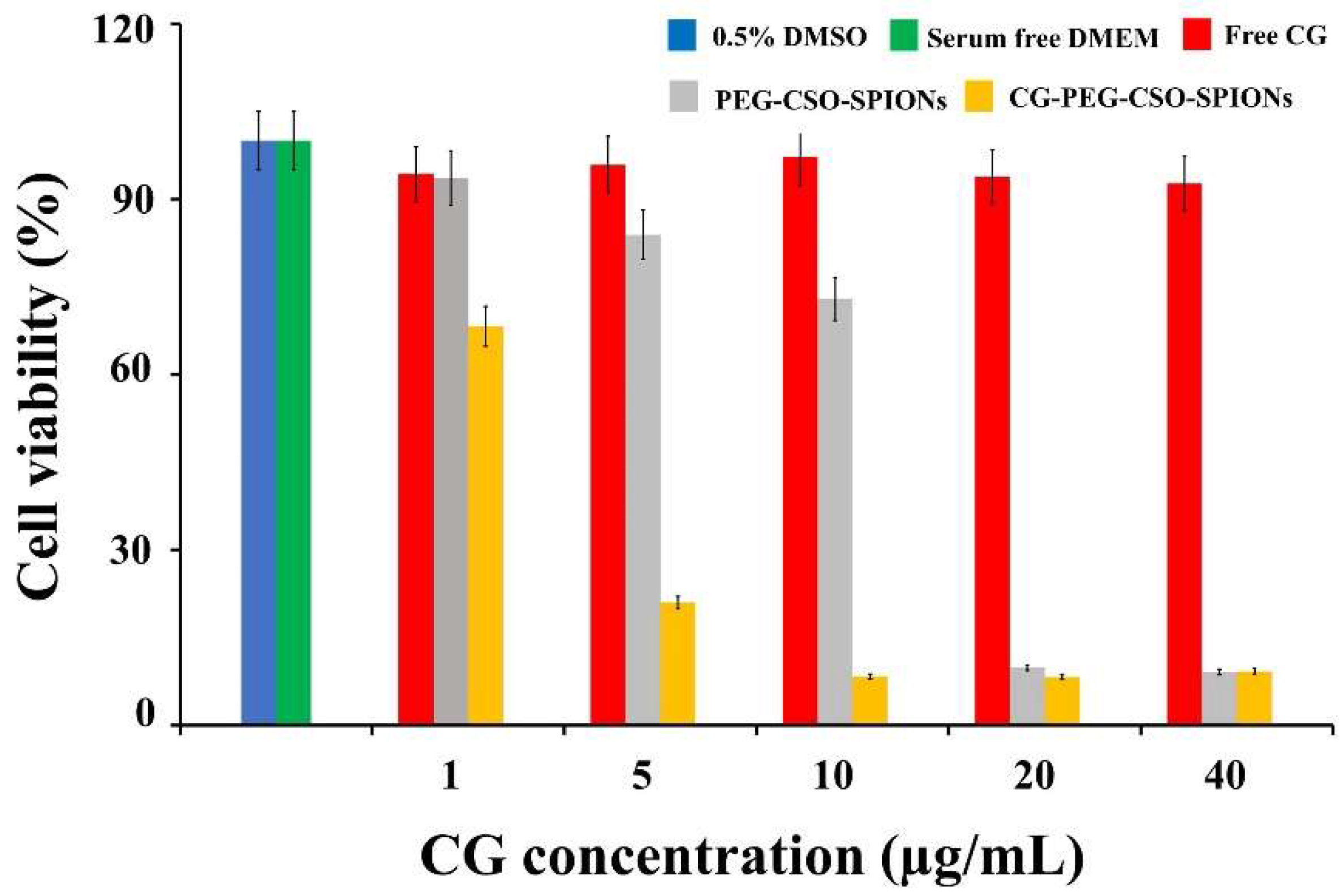
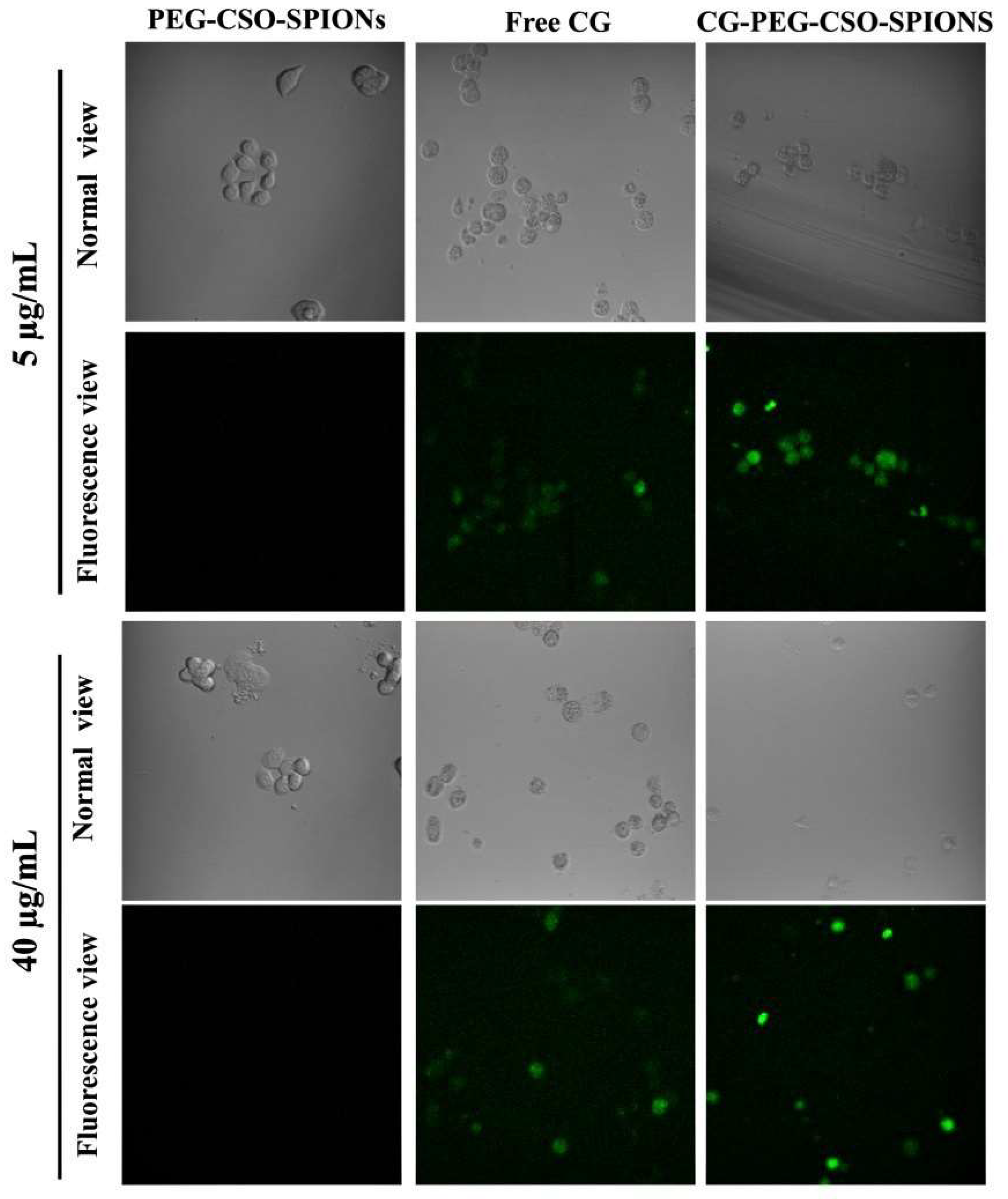

| Factor | Level | |
| Low (−) | High (+) | |
| X1 = CTAB concentration (mg/mL) | 2.5 | 7.5 |
| X2 = CSO concentration (mg/mL) | 0.1 | 0.3 |
| X3 = PEG concentration (mg/mL) | 0.1 | 0.3 |
| X4 = Molecular weight of PEG (Da) | 1000 | 3000 |
| X5 = CG concentration (mg/mL) | 0.2 | 0.4 |
| Response | Constraint | |
| Y1 = Particle size (nm) | Minimize | |
| Y2 = Zeta potential (mV) | ≥ ±20 mV | |
| Y3 = LE (%) | Maximize | |
| Y4 = LC (%) | Maximize | |
| Run | Factor (X1–5) | Response (Y1–4) | |||||||
|---|---|---|---|---|---|---|---|---|---|
| X1 | X2 | X3 | X4 | X5 | Y1 | Y2 | Y3 | Y4 | |
| 1 | 7.5 | 0.3 | 0.1 | 3000 | 0.4 | 435 ± 23 | 25.2 ± 1.1 | 40.5 ± 3.2 | 4.7 ± 1.3 |
| 2 | 2.5 | 0.3 | 0.3 | 1000 | 0.4 | 512 ± 37 | 19.3 ± 0.8 | 33.4 ± 4.6 | 3.2 ± 0.6 |
| 3 | 7.5 | 0.1 | 0.3 | 3000 | 0.2 | 492 ± 17 | 31.1 ± 0.4 | 35.4 ± 2.8 | 4.5 ± 1.6 |
| 4 | 2.5 | 0.3 | 0.1 | 3000 | 0.4 | 323 ± 28 | 20.2 ± 0.7 | 37.5 ± 1.9 | 3.8 ± 0.3 |
| 5 | 2.5 | 0.1 | 0.3 | 1000 | 0.4 | 387 ± 42 | 24.2 ± 1.2 | 45.1 ± 5.2 | 3.8 ± 1.1 |
| 6 | 2.5 | 0.1 | 0.1 | 3000 | 0.2 | 218 ± 18 | 23.2 ± 1.9 | 55.1 ± 6.7 | 5.7 ± 1.9 |
| 7 | 7.5 | 0.1 | 0.1 | 1000 | 0.4 | 238 ± 24 | 33.2 ± 0.2 | 68.4 ± 2.2 | 7.1 ± 0.8 |
| 8 | 7.5 | 0.3 | 0.1 | 1000 | 0.2 | 365 ± 32 | 23.2 ± 0.1 | 54.9 ± 3.6 | 5.7 ± 2.1 |
| 9 | 7.5 | 0.3 | 0.3 | 1000 | 0.2 | 575 ± 11 | 25.4 ± 0.9 | 35.9 ± 1.9 | 3.7 ± 1.4 |
| 10 | 2.5 | 0.3 | 0.3 | 3000 | 0.2 | 516 ± 12 | 19.2 ± 1.4 | 29.3 ± 3.2 | 3.1 ± 0.8 |
| 11 | 7.5 | 0.1 | 0.3 | 3000 | 0.4 | 497 ± 29 | 32.9 ± 2.1 | 32.8 ± 3.8 | 3.4 ± 0.7 |
| 12 | 2.5 | 0.1 | 0.1 | 1000 | 0.2 | 169 ± 16 | 25.8 ± 1.8 | 62.4 ± 5.1 | 6.4 ± 1.2 |
| 13 * | 5 | 0.2 | 0.2 | 2000 | 0.3 | 365 ± 34 | 28.3 ± 1.5 | 67.1 ± 2.3 | 6.9 ± 1.8 |
| 14 * | 5 | 0.2 | 0.2 | 2000 | 0.3 | 372 ± 41 | 29.6 ± 1.7 | 68.2 ± 1.6 | 7.1 ± 1.7 |
| 15 * | 5 | 0.2 | 0.2 | 2000 | 0.3 | 368 ± 37 | 28.2 ± 0.9 | 66.4 ± 1.2 | 6.8 ± 2.2 |
| Factor | Level | ||
| Low (−) | Medium (0) | High (+) | |
| X1 = CTAB concentration (mg/mL) | 2.5 | 5.0 | 7.5 |
| X2 = CSO concentration (mg/mL) | 0.1 | 0.2 | 0.3 |
| X3 = PEG concentration (mg/mL) | 0.1 | 0.2 | 0.3 |
| Response | Constraint | ||
| Y1 = Particle size (nm) | Minimize | ||
| Y2 = Zeta potential (mV) | ≥ ±20 mV | ||
| Y3 = LE (%) | Maximize | ||
| Y4 = LC (%) | Maximize | ||
| Run | Factor (X1–3) | Response (Y1–4) | |||||
|---|---|---|---|---|---|---|---|
| X1 | X2 | X3 | Y1 | Y2 | Y3 | Y4 | |
| 1 | 2.5 | 0.1 | 0.2 | 102 ± 22 | 20.2 ± 2.3 | 71.7 ± 3.4 | 6.5 ± 1.5 |
| 2 | 7.5 | 0.1 | 0.2 | 232 ± 17 | 31.4 ± 1.7 | 67.3 ± 5.7 | 4.3 ± 0.8 |
| 3 | 2.5 | 0.3 | 0.2 | 172 ± 13 | 27.2 ± 2.5 | 80.3 ± 3.7 | 5.5 ± 2.1 |
| 4 | 7.5 | 0.3 | 0.2 | 348 ± 35 | 33.1 ± 1.6 | 79.6 ± 2.1 | 6.2 ± 1.6 |
| 5 | 2.5 | 0.2 | 0.1 | 92 ± 32 | 20.2 ± 1.9 | 48.9 ± 5.4 | 4.8 ± 2.4 |
| 6 | 7.5 | 0.2 | 0.1 | 204 ± 11 | 29.4 ± 0.8 | 43.5 ± 4.6 | 7.7 ± 2.8 |
| 7 | 2.5 | 0.2 | 0.3 | 180 ± 28 | 23.5 ± 2.9 | 86.4 ± 3.2 | 7.4 ± 0.6 |
| 8 | 7.5 | 0.2 | 0.3 | 362 ± 19 | 30.3 ± 1.1 | 78.9 ± 7.8 | 3.1 ± 1.1 |
| 9 | 5 | 0.1 | 0.1 | 125 ± 37 | 26.1 ± 2.1 | 45.9 ± 5.2 | 11.3 ± 0.6 |
| 10 | 5 | 0.3 | 0.1 | 196 ± 18 | 30.2 ± 1.3 | 59.1 ± 2.3 | 12.3 ± 1.3 |
| 11 | 5 | 0.1 | 0.3 | 218 ± 32 | 25.8 ± 1.5 | 82.7 ± 5.9 | 10.6 ± 1.5 |
| 12 | 5 | 0.3 | 0.3 | 334 ± 25 | 32.1 ± 2.2 | 85.2 ± 8.3 | 10.9 ± 2.5 |
| 13 * | 5 | 0.2 | 0.2 | 188 ± 34 | 29.4 ± 1.8 | 52.8 ± 2.5 | 11.0 ± 1.8 |
| 14 * | 5 | 0.2 | 0.2 | 191 ± 24 | 31.3 ± 0.7 | 55.3 ± 9.2 | 11.4 ± 0.6 |
| 15 * | 5 | 0.2 | 0.2 | 185 ± 31 | 28.3 ± 1.2 | 53.1 ± 7.3 | 11.3 ± 1.2 |
| Response | F-Value | R2 | R2adjusted | R2predicted | Lack of Fit | Remark |
|---|---|---|---|---|---|---|
| Response Y1 (Particle Size) | ||||||
| Linear | 81.84 | 0.9571 | 0.9454 | 0.9217 | 0.0198 | - |
| 2FI | 68.61 | 0.9809 | 0.9666 | 0.9553 | 0.0296 | - |
| Quadratic | 820.04 | 0.9993 | 0.9981 | 0.9918 | 0.3893 | Suggested |
| Statistically significant factors for Y1 (p < 0.05) is X1, X2 and X3 | ||||||
| Response Y2 (zeta potential) | ||||||
| Linear | 6.29 | 0.6316 | 0.5311 | 0.3324 | 0.0314 | - |
| 2FI | 6.24 | 0.8238 | 0.6917 | 0.5719 | 0.0437 | - |
| Quadratic | 125.28 | 0.9840 | 0.9552 | 0.8790 | 0.7375 | Suggested |
| Statistically significant factors for Y2 (p < 0.05) is X1 and X2 | ||||||
| Response Y3 (LE) | ||||||
| Linear | 10.89 | 0.7482 | 0.6795 | 0.5963 | 0.0197 | - |
| 2FI | 4.18 | 0.7580 | 0.5765 | 0.2817 | 0.0137 | - |
| Quadratic | 68.02 | 0.9919 | 0.9773 | 0.8856 | 0.1982 | Suggested |
| Statistically significant factors for Y3 (p < 0.05) is X1, X2 and X3 | ||||||
| Response Y4 (LC) | ||||||
| Linear | 0.11 | 0.0279 | −0.2373 | −0.8894 | 0.0030 | - |
| 2FI | 0.22 | 0.1404 | −0.5043 | −2.7683 | 0.0022 | - |
| Quadratic | 685.94 | 0.9992 | 0.9977 | 0.9959 | 0.9064 | Significant |
| Statistically significant factors for Y3 (p < 0.05) is X1, X2 and X3 | ||||||
| Factor | Optimum | Response | Predicted | Observed | % Error |
|---|---|---|---|---|---|
| CTAB (mg/mL) | 2.8 | Particle size (nm) | 133 | 143 | 6.8 |
| CSO (mg/mL) | 0.10 | Zeta potential (mV) | 30.6 | 28.2 | 8.51 |
| PEG (mg/mL) | 0.26 | LE (%) | 83.3 | 80.2 | 3.76 |
| LC (%) | 8.34 | 7.94 | 4.79 | ||
| Criterion for optimization = minimum particle size, ≥ ±20 mV of zeta potential, maximum LE and LCDesirability value = 0.96 | |||||
© 2020 by the authors. Licensee MDPI, Basel, Switzerland. This article is an open access article distributed under the terms and conditions of the Creative Commons Attribution (CC BY) license (http://creativecommons.org/licenses/by/4.0/).
Share and Cite
Sorasitthiyanukarn, F.N.; Muangnoi, C.; Thaweesest, W.; Ratnatilaka Na Bhuket, P.; Jantaratana, P.; Rojsitthisak, P.; Rojsitthisak, P. Polyethylene Glycol-Chitosan Oligosaccharide-Coated Superparamagnetic Iron Oxide Nanoparticles: A Novel Drug Delivery System for Curcumin Diglutaric Acid. Biomolecules 2020, 10, 73. https://doi.org/10.3390/biom10010073
Sorasitthiyanukarn FN, Muangnoi C, Thaweesest W, Ratnatilaka Na Bhuket P, Jantaratana P, Rojsitthisak P, Rojsitthisak P. Polyethylene Glycol-Chitosan Oligosaccharide-Coated Superparamagnetic Iron Oxide Nanoparticles: A Novel Drug Delivery System for Curcumin Diglutaric Acid. Biomolecules. 2020; 10(1):73. https://doi.org/10.3390/biom10010073
Chicago/Turabian StyleSorasitthiyanukarn, Feuangthit Niyamissara, Chawanphat Muangnoi, Wuttinont Thaweesest, Pahweenvaj Ratnatilaka Na Bhuket, Pongsakorn Jantaratana, Pornchai Rojsitthisak, and Pranee Rojsitthisak. 2020. "Polyethylene Glycol-Chitosan Oligosaccharide-Coated Superparamagnetic Iron Oxide Nanoparticles: A Novel Drug Delivery System for Curcumin Diglutaric Acid" Biomolecules 10, no. 1: 73. https://doi.org/10.3390/biom10010073
APA StyleSorasitthiyanukarn, F. N., Muangnoi, C., Thaweesest, W., Ratnatilaka Na Bhuket, P., Jantaratana, P., Rojsitthisak, P., & Rojsitthisak, P. (2020). Polyethylene Glycol-Chitosan Oligosaccharide-Coated Superparamagnetic Iron Oxide Nanoparticles: A Novel Drug Delivery System for Curcumin Diglutaric Acid. Biomolecules, 10(1), 73. https://doi.org/10.3390/biom10010073







